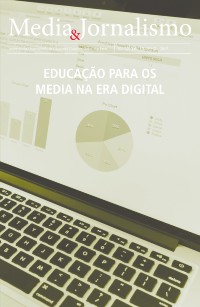Please use this identifier to cite or link to this item:
https://hdl.handle.net/10316.2/38142| DC Field | Value | Language |
|---|---|---|
| dc.contributor.author | Andrelo, Roseane | - |
| dc.contributor.author | Almeida, Lígia Carvalho de | - |
| dc.date.accessioned | 2015-11-27T11:34:36Z | |
| dc.date.accessioned | 2020-10-04T03:37:01Z | - |
| dc.date.available | 2015-11-27T11:34:36Z | |
| dc.date.available | 2020-10-04T03:37:01Z | - |
| dc.date.issued | 2015 | - |
| dc.identifier.issn | 1645‑5681 | - |
| dc.identifier.issn | 2183-5462 (digital) | - |
| dc.identifier.uri | https://hdl.handle.net/10316.2/38142 | - |
| dc.description.abstract | A experiência brasileira revela que, apesar da presença do rádio nas escolas básicas, seu potencial é subaproveitado por educadores que não detêm conhecimento aprofundado sobre a estrutura de sua linguagem, composta por palavra, músicas, efeitos sonoros e silêncio, sobretudo no que diz respeito a três aspectos centrais: a oralidade, a interatividade e a mídia‑educação. Assim, com base no conhecimento empírico das autoras e em literatura especializada, analisa‑se o potencial da linguagem radiofônica, considerada o alicerce para o uso educativo do rádio, tanto em suporte analógico quanto em digital. Contando com apoio de ambiente virtual, delineia‑se uma proposta para o ensino de artes, alinhada aos Parâmetros Curriculares Nacionais, que solicitam o despertamento da sensibilidade, da criatividade e o enfoque da diversidade de manifestações artísticas e culturais nas escolas básicas. | por |
| dc.description.abstract | The Brazilian experience shows that, despite the presence of radio in elementary schools, the potential for education of this medium is under‑utilized by educators who do not hold in‑depth knowledge about the structure of the language of the radio (which consists of words, music, sound effects and silence), especially in three central aspects: orality, interactivity and media education. Thus, based on empirical knowledge of the authors and in specialized literature, the potential of radio language is analyzed, due to the fact that this language is considered the foundation for the educational use of radio, both in analog and in digital supports. Aiming to awake the sensitivity and the creativity in primary schools’ students and focusing on the promotion of their artistic and cultural diversity, we present a proposal for arts education in line with the National Curriculum’s Parameters, to be developed with the aid of virtual media. | eng |
| dc.language.iso | por | - |
| dc.publisher | Imprensa da Universidade de Coimbra | - |
| dc.rights | open access | - |
| dc.subject | Radio | eng |
| dc.subject | media education | eng |
| dc.subject | radio language | eng |
| dc.subject | orality | eng |
| dc.subject | interactivity | eng |
| dc.subject | Rádio | por |
| dc.subject | mídia‑educação | por |
| dc.subject | linguagem radiofônica | por |
| dc.subject | oralidade | por |
| dc.subject | interatividade | por |
| dc.title | O rádio na educação: explorando a linguagem radiofônica no estudo das artes | por |
| dc.title.alternative | The radio in education: exploring radio language in the study of the arts | por |
| dc.type | article | - |
| uc.publication.collection | Media & Jornalismo nº 27, vol. 15, nº 2 | - |
| uc.publication.firstPage | 107 | - |
| uc.publication.issue | 27 | - |
| uc.publication.lastPage | 124 | - |
| uc.publication.location | Coimbra | - |
| uc.publication.journalTitle | Media & Jornalismo: uma revista do Centro de Investigação Media e Jornalismo | - |
| uc.publication.volume | 15 | por |
| dc.identifier.doi | 10.14195/2183-5462_27_5 | - |
| uc.publication.section | Artigos | - |
| uc.publication.orderno | 7 | - |
| uc.publication.area | Artes e Humanidades | - |
| uc.publication.manifest | https://dl.uc.pt/json/iiif/10316.2/38142/264530/manifest?manifest=/json/iiif/10316.2/38142/264530/manifest | - |
| uc.publication.thumbnail | https://dl.uc.pt/retrieve/12086448 | - |
| item.grantfulltext | open | - |
| item.fulltext | With Fulltext | - |
| Appears in Collections: | Media & Jornalismo | |
Files in This Item:
| File | Description | Size | Format | |
|---|---|---|---|---|
| o_radio_na_educacao.pdf | 12.09 MB | Adobe PDF |  |
Items in DSpace are protected by copyright, with all rights reserved, unless otherwise indicated.
